|
Dull Church. 2003 Excavation Report.
After reviewing the work carried out
during the excavations at Dull in 2002, (see report in the 2003 Clan
Annual) it was considered that the results justified carrying out further
excavations in 2003. Because the site was becoming of considerable
importance I felt that continued professional support was necessary and
hoped that sufficient funding could be raised to cover this.
In the event, our proposed dates
coincided with the first ever Perthshire Archaeological Week, intended to
encourage the general public to visit places of historical interest. As
ours was the only active excavation during that week, the Perth and
Kinross Heritage Trust and the Perthshire Tourist Board agreed to
contribute to the funding on condition that the excavation was open to the
public. This we very happily agreed to. The breadalbane Heritage Society
and Struan Robertson of Geneva again kindly made contributions, and so it
was ‘all systems GO!’
On the morning of Saturday, June
14th we re-assembled at Dull Kirk, duly admired the magnificent blue
portable toilet that had been installed by the gate and carried all the
equipment inside, ready to start. Bob Will from Glasgow University
Archaeological Research Division (GUARD) was again joining us to give us
the benefit of his considerable experience.
We were also pleased to welcome
Paul Duffy, Forensics and Human Remains Officer at GUARD who was spending
the week with us and was intending to carry out detailed analysis of the
human remains uncovered. He was hoping to obtain information such as age
at death, sex, stature, and inherent health problems such as dental
disease, degenerative joint disease, traumatic injury, nutritional
disorders and infectious diseases. He had brought a German student along
with him to give her some practical experience.
As owner Suki Urquhart had allowed
us to leave all the spoil from the previous year in the room adjoining the
nave we were able to get cracking straight away. The first task was to
continue removing the rubble scattered across the nave. I was clearing the
north-west section and within some thirty minutes of starting, on lifting
a largish flat stone and turning it over was amazed to see a beautiful
cross and some lettering engraved on the underside. This caused great
excitement. Photographs were taken and everyone attempted to decipher the
lettering. The consensus seemed to favour ‘becli’ but this was not
unanimous.
The stone was carefully lifted and
placed on the carpeted area by the font, where it was greatly admired by
the visitors who were starting to arrive in numbers as a result of the
Perthshire Archaeological Week publicity. Each group of visitors was given
a guided tour and encouraged to ask questions. The feedback was extremely
positive and several of them returned at intervals during the week to
watch progress. Two of them asked if they could help by wheeling the
barrow loads of spoil for us, an offer that was gratefully accepted! One
of them was a New Zealander on holiday with his wife. He returned to work
again the next day while his wife went shopping - wise man!
At the end of the ten days we had
seen well over two hundred visitors from as far away as the U.S.A., South
Africa, Sweden, New Zealand and the Netherlands, as well as from all over
the U.K. In preparation for the expected visitors I had produced a leaflet
that briefly explained the excavation and its background, based on my
report in the Clan Annual. This had been printed onto a single sheet of
paper, and I was able to persuade many of the visitors to contribute £1.00
for a copy. When the excavation was finished we were able to add £150.00
to the Clan Appeal.
Clearance of the rubble in the nave
was completed and selected areas were carefully trowelled to remove the
underlying silty loam. As before, few artefacts were found but this was to
be expected in view of the location. A few possible coffin nails and
shroud pins appeared, and surprisingly, an iron arrow head. My theory was
that it had come into the kirk between the ribs of one of the bodies
buried there. Everyone laughed, but they couldn't say I was wrong!
As before, disarticulated human
remains appeared and these passed to Paul for his examination. He was
happy to break off to explain his work to the visitors, and there was
often an enthralled crowd surrounding his table. His initial thoughts were
that the population had good general health, although there were some
indications of arthritis. There was little evidence of tooth decay,
presumably due to the lack of sugar in the diet but tooth wear was noted,
possibly because of the use of stone ground bread. A few remains of
children appeared. Paul said that child remains of this period were often
under about the age of seven. After this age they have usually survived
the normal childhood illnesses and grow up to adulthood.
On the Sunday we had visitors from
the University and they took the photographs of the incised cross back
with them to Glasgow. On the next morning we had a phone call to say that
everyone was very excited and the first thoughts were ;
1) it showed Irish influence (not
surprising, as Christianity came to the Highlands from Ireland via Iona),
2) it was probably 8th Century - which
ties in with the founding of the Dull Abbey by St. Ninian, who died in 704
AD,
3) it probably covered the grave of an
Abbot, as only Abbots had elaborate gravestones, and
4) it is the only one of its type that
has been found on the Scottish mainland.
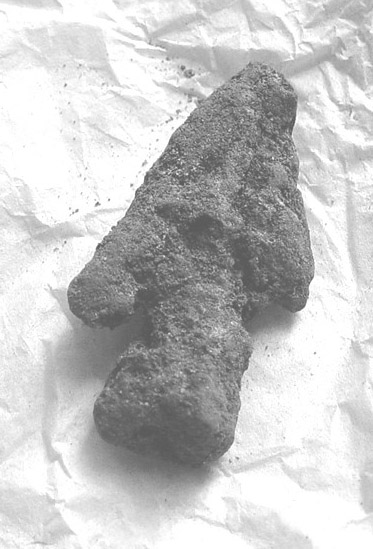
Arrowhead
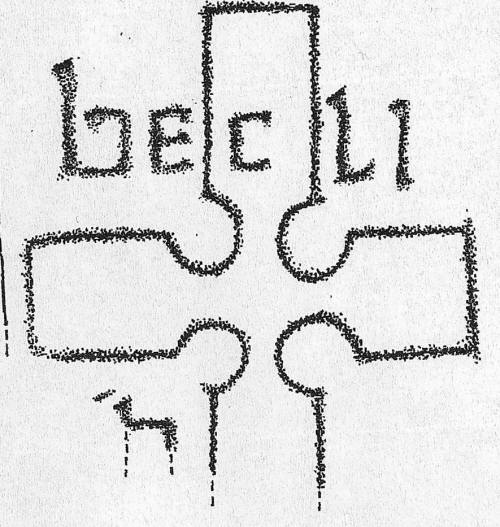
Becli
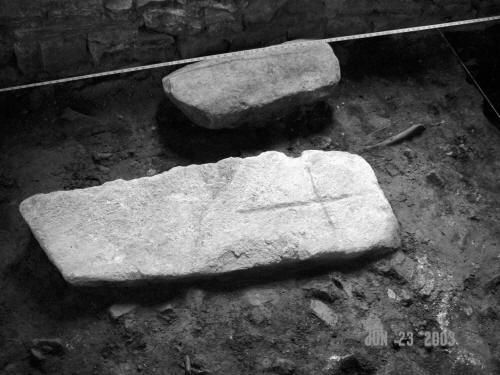
Big Stone
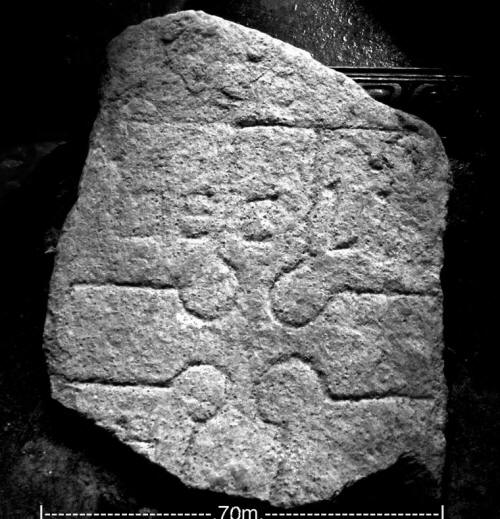
Good Stone
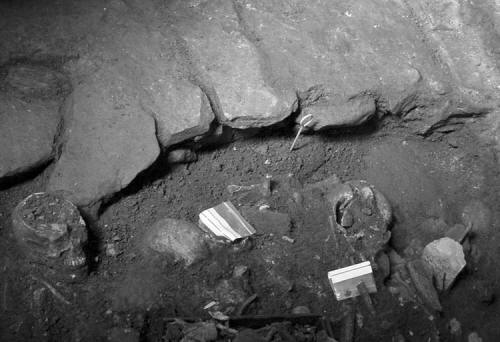
Wall
Cheers all round!
The final resting-place for the
cross will be the decided by the Scottish Treasure Trove Panel, who have
not yet been asked to examine it. In the meantime a professional artist
has drawn it and the lettering does appear to be ‘becli’. Some guesses are
that it might be a Pictish name, or even a female name.
Work continued throughout the week
and human remains continued to appear. The clay bonded wall remains of an
earlier building that were found under the west end of the nave last
November were further excavated, but as they ran across the nave and
disappeared under the walls of the existing building we were not able to
learn anything new from them. As the level of the excavations went down,
we started to discover complete burials. We did not disturb these. They
are probably the reason for the disarticulated remains when earlier
burials were disturbed as these later remains were interred.
The final discovery was made as we
were clearing up on the last Saturday. A large oblong stone in the nave
that had been left in place because of its size was being brushed down
when a large incised cross was revealed on the top. Most embarrassing, as
we had been using it as a stepping stone all week! It probably covered the
grave of a monk, as monks led a simple life and in death had a simple
gravestone. We cannot say if it is in its original position and we did not
attempt to lift it.
So, the Dull Kirk excavations have
come to an end for the foreseeable future. A new floor has been laid,
although the planks have been screwed down so that they could be lifted
again. If another opportunity occurs, and sufficient funding for
professional assistance raised, it would be interesting to look under the
east (altar) end to see if we can trace further remains of the earlier
building and perhaps identify it.
Donnachadh Reamhair is believed to
be buried at Dull. It may be possible to find evidence for this but it
must be emphasised that it is most unlikely. If he was buried there, we
don't know whether it was inside or outside the kirk, or what area the
kirk of that time covered, or even where it was. I think it would be
better to let sleeping chiefs lie.
The report by Paul Duffy on the
skeletal remains makes interesting reading. A minimum of 18 individuals
were identified and at least six were male and seven female, indicating a
roughly equal balance in the sexes. The remains of at least four juveniles
were present.
Where it was possible to estimate
approximate age at death the result was
Age 1 - 10 - - -
- - - - - 3
10 20 - - - -
- - - - - 1
20 30 - - - -
- - - - - 1
30 40 - - - -
- - - - - 7
40 50 - - - -
- - - - - 2
50 + - - -
- - - - - 6
Paul expressed surprise at the
peak of deaths in the 30-40 age range. He expected a pre-modern population
to peak in under 10 and over 50, with both groups vulnerable to disease
etc. in the absence of modern medicine.
Donald Reid. |

